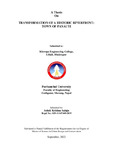Please use this identifier to cite or link to this item:
https://elibrary.khec.edu.np:8080/handle/123456789/522Full metadata record
| DC Field | Value | Language |
|---|---|---|
| dc.contributor.advisor | Ar. Biresh Shah, | - |
| dc.contributor.author | Sainju, Ashok Krishna | - |
| dc.date.accessioned | 2023-06-09T09:50:56Z | - |
| dc.date.available | 2023-06-09T09:50:56Z | - |
| dc.date.issued | 2022-02 | - |
| dc.identifier.uri | https://elibrary.khec.edu.np/handle/123456789/522 | - |
| dc.description.abstract | A historic process of adaptation to the ever-changing needs of the time is the transformation of a settlement’s-built environment. The town of Panauti, which dates back to the 13th century, has an air of having been overlooked by time. Due to its location on the same rock, it is frequently referred to as a city that is not affected by earthquakes. The thesis focuses on identifying Panauti's historical context, current state of historical riverfront, and the factors that led to its transformation. The paper describes the process of transformation in depth from historical, sociocultural, and physical perspectives. This also shows how new construction has affected the neighborhood and the historic town. The study's objectives are to ascertain how the area's function has changed, to ascertain the current state of Panauti's historic riverfront through a study of its current urban landscapes and its effects on Panauti's traditional, cultural, social, and economic life, and to suggest some urban redevelopment strategies to lessen their detrimental environmental effects and open up new opportunities for the city's core. These days, the values of the community have changed in addition to the settlement's morphology in Panauti. Few locals who are still living there are even moving elsewhere as the area is in decline. During festivals, the area has become a deserted settlement with few people present. At the same time, homes are being constructed along the new settlement nearby buspark area leading from Panauti to the new community, leaving the old town deserted and quiet. The research methods adopted are site selection, problem identification, formulation of objectives, literature review, data collection, questionnaire survey, physical observation, photographs as data, mapping and the secondary data collection such as base maps, cadastral maps and aerial photos have been collected through related institutions and personnel. Aerial photographs and the CBS data will be used to identify the change pattern in spatial physical and social boundary. The study's primary focus will be on the factors that contributed to Panauti's historic settlement and riverfront's transformation between 1976 and 2022. The stretch includes a range of areas, including cultural ghats, monuments, and undeveloped terrain, and it represents the full river stretch in the historic town of Panauti. To achieve the riverfront revitalization, a concept and few strategies are offered as recommendations, which will help to understand the potential outcomes for Panauti after the riverfront revitalization. | en_US |
| dc.language.iso | en | en_US |
| dc.title | TRANSFORMATION OF A HISTORIC RIVERFRONT: TOWN OF PANAUTI | en_US |
| dc.type | Thesis | en_US |
| local.college.name | Khwopa Engineering College | - |
| local.degree.name | MSc in Urban Design and Conservation | - |
| local.degree.level | Masters | - |
| Appears in Collections: | Master of Science (M.Sc) in Urban Design and Conservation | |
Files in This Item:
| File | Description | Size | Format | |
|---|---|---|---|---|
| Updated_PU-Thesis-Ashok-Krishna-Sainju.pdf Restricted Access | 11.55 MB | Adobe PDF |  View/Open Request a copy |
Items in DSpace are protected by copyright, with all rights reserved, unless otherwise indicated.
